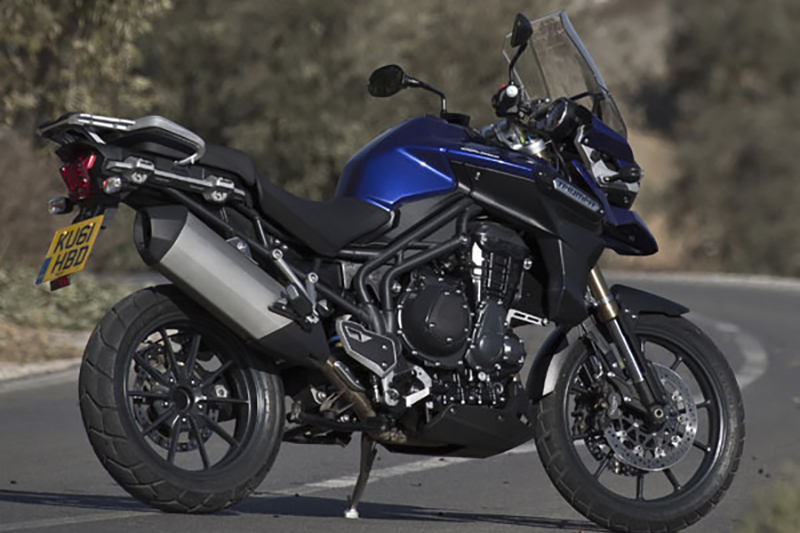2012 Triumph Tiger Explorer

First Ride Review
Leaned over mid-corner, the toe of my boot scraping the tarmac and adrenalin crackling through my veins, rolling on the throttle induces a deep, guttural bark from the stainless-steel exhaust pipe. The rear tire hits something slick, perhaps a thin line of diesel fuel slopped onto the roadway by that smoke-belching, errantly driven tanker truck I passed going the other way a few klicks back. The tire slips and the rear end steps out momentarily, but the TC light flashes and the bike regains traction before my cheeks can clench involuntarily. Crisis averted, I continue driving hard out of the corner, standing the bike up and blasting down a short straight before the next blind left-hander. Though I’ve never ridden this bike before, it feels familiar, like an old friend. I’ve all but forgotten yesterday’s marathon, intercontinental trip to Andalucia, Spain, and the two high-octane café solo dobles I slurped down over breakfast burned off the last fog of my jet lag. Right now, on a crisp mid-February morning under sunny blue skies, I’m focused on the serpentine road beneath me, riding what feels like a hooligan bike fed a steady diet of steroids and growth hormone.
With a target on its back for years, the BMW R 1200 GS has fended off multiple competitive attacks. The Suzuki V-Strom 1000 turned out to be more of a street bike, the KTM 990 Adventure more of a dirt bike. Then came the Yamaha Super Ténéré, its 1,199cc parallel twin making power and torque comparable to the latest DOHC iteration of BMW’s 1,170cc boxer, and both offering low-maintenance shaft final drive. But the Super Ténéré is heavy and its ABS can’t be turned off, limiting its versatility. The latest offensive in the ADV wars comes from Triumph, one year after releasing the Tiger 800/XC (Rider’s 2011 Motorcycle of the Year), a two-pronged attack on BMW’s F 650 GS and F 800 GS. The all-new 2012 Triumph Tiger Explorer is a 1,200cc, shaft-driven, competitively priced adventure tourer aimed directly at the R 1200 GS. With standard ABS, traction control, cruise control, adjustable ergonomics and more, it comes out guns a-blazin’ with a base price of $15,699, offering more for less than the BMW.
The latest Tri-oomph is powered by a liquid-cooled, DOHC transverse in-line triple with four valves per cylinder. Its 71.4mm stroke is shared with the 1,050cc mill found in the Tiger 1050, Sprint GT and Speed Triple, but its architecture is closer to that of the 675cc engine found in the Daytona and Street Triple. An 85mm bore (6mm more than the 1050) yields a class-leading displacement of 1,215cc, which Triumph says is good for 135 horsepower at 9,000 rpm and 89 lb-ft of torque at 6,400 rpm, with 74 lb-ft on tap from 2,500 rpm until redline (9,500 rpm). Such a broad spread of torque is a signature trait of Triumph triples, as is the uniquely addictive exhaust note. Leave the Tiger Explorer in third gear; it pulls like a diesel out of corners and steadily spins up to a screaming top-end. Or shift regularly to keep the triple near its torque peak; the hydraulically actuated wet clutch and 6-speed transmission work flawlessly.
The Tiger Explorer’s engine features wet liner construction and piston spray jets for improved cooling, an internal oil/water heat exchanger for fewer exposed parts and a back-torque limiter on the starter motor to prevent excessive wear and tear. Since adventure riders like farkles—heated grips, fog lights, GPS units, etc.—the generator pumps out a generous 950 watts. Rather than being driven off the end of the crankshaft, it is mounted atop the engine and runs off the clutch basket via an overrun decoupler to provide consistent output regardless of engine speed. And the Explorer is the first Triumph with throttle-by-wire, which enables electronic cruise control and traction control and optimizes emissions and fuel efficiency. Triumph claims 43 mpg at 75 mph and 57 mpg at 55mph, yielding a range of 228-302 miles from the 5.3-gallon tank.
Its triple is unmistakably Triumph, but other key features of the Tiger Explorer—a tubular steel space frame that uses the engine as a stressed member, a cast aluminum single-sided swingarm, shaft final drive with parallelogram geometry and a pronounced beak extending from the front fairing—mimic the BMW R 1200 GS. Imitation is the sincerest form of flattery, as well as a way to poach customers. The Explorer’s ADV bona fides also include ABS and traction control that can be turned off (both default to “on” when the key is switched off, and you have to dig deep into the setup menu by repeatedly pressing buttons to turn them off), 19-inch front/17-inch rear cast wheels shod with Metzeler Tourance EXP tires (spoked wheels like those found on the Tiger 800XC are not an option), long-travel suspension, tough-guy bodywork and a long list of go-anywhere accessories. Useful touches include a centerstand, a cast aluminum luggage rack, cleated footpegs with removable rubber inserts and a forged aluminum sidestand with a large footprint to prevent sinking into soft surfaces. One potentially limiting factor, however, is weight. Triumph claims 570 pounds ready to ride, which, if accurate, is 32 pounds heavier than the last BMW R 1200 GS we tested and just a few pounds shy of the Yamaha Super Ténéré. Load capacity is said to be 489 pounds—considerably more than most bikes available today.
Our test ride in Spain was short—less than 100 miles on the street and a short blast offroad—but enough for a first impression. The Tiger Explorer is comfortable and can be made to fit a range of riders, with a supportive seat that can be set at 32.9 or 33.7 inches (accessory comfort, heated, low and high seats are available), a wide handlebar with fore/aft adjustable risers and a height-adjustable windscreen with good coverage. Its throttle-by-wire system provides crisp throttle response, driveline lash is minimal and ride quality is high, with metalastic driveshaft bushings, a torsional damper between the shaft and transmission, a counterbalancer and a hefty flywheel nullifying unwanted vibration. Handling is neutral, with easy turn-in and good stability through both tight and fast corners. The 46mm male-slider fork is adjustable for preload only and the remote-reservoir rear shock is adjustable for preload (via remote knob) and rebound. Made by Kayaba, the suspension offers 7.5/7.6 inches of front/rear travel and soaks up rough pavement with ease. Powerful Nissin brakes—dual 4-piston front calipers and a single 2-piston rear caliper—scrub off speed well, but they could use more initial bite and better feedback.
In standard trim, the Tiger Explorer is packed with features, some never before offered on a Triumph, such as a traction control system with two modes plus off. Mode 1 allows virtually no rear wheel slip and is ideal for the street (see first paragraph); Mode 2 allows limited slip and works well offroad, where you can steer a bit with the rear without getting badly out of shape on such a heavy bike. I just wish it, along with the ABS, was easier to turn off. Cruise control, a popular touring feature not normally found on adventure bikes, can be easily set and adjusted using buttons on the right handgrip. An analog tachometer is paired with a feature-rich LCD display showing speed, fuel level, gear position, engine temperature and clock, plus a custom-settable information reading. On the left handgrip, a menu button and a toggle switch navigate through information functions—trip 1 data, trip 2 data, ambient temperature, tire pressure (if the accessory sensors are fitted) and setup (for ABS, TC and other functions). A wealth of useful information is available, including fuel consumption (average, instant, range to empty), average speed, cruise control set speed, odometer and distance, though it would be preferable to show ambient temperature and trip function simultaneously rather than just one or the other. An auxiliary power socket and a coded key ignition immobilizer are also standard.
Anyone who owns or has ridden adventure tourers knows that their greatest strength is versatility. Comfortable, upright seating, large fuel tanks and the ability to carry lots of gear make them great for long distances; torquey engines, beefy suspension and brakes, and ample cornering clearance make them great for tackling any road in any condition at almost any speed; and durable chassis and components make them capable of venturing offroad, whether such escapades are a dream or reality. The 2012 Triumph Tiger Explorer checks all of these boxes while offering many useful features at a competitive price. Available in Phantom Black, Graphite or Sapphire Blue, it should be in dealers later this spring. Will it outgun the BMW R 1200 GS or Yamaha Super Ténéré? It certainly has the potential, but a down-and-dirty shootout is the only way to know for sure.
